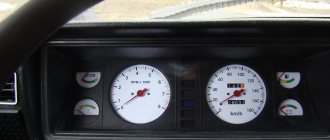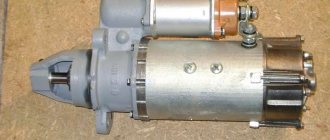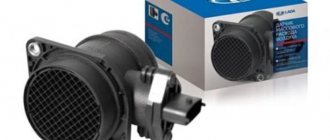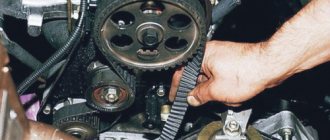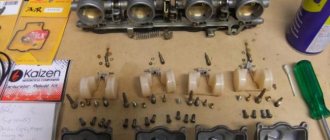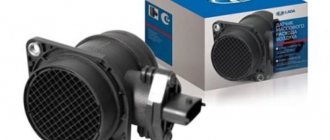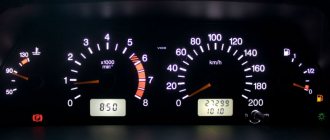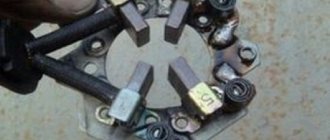01/26/2022 6 168 Dashboard
Author: Ivan Baranov
Every modern car must be equipped with a tachometer. This device is a device designed to measure crankshaft rotation speed. Like any other device, this device can fail over time. How to check the tachometer at home, and for what reasons it may fail - look for answers to these questions below.
[Hide]
How to check the tachometer yourself? Methods, tips and tricks
Not many drivers know how to check the tachometer - one of the most important instruments in a car, which allows you to measure the number of engine revolutions.
With its help, the driver can maintain full control over the operation of the engine so that the speed does not exceed the permissible values, and the engine does not fail in the future, since its repair will cost car owners a pretty penny. In other words, its main function is to simplify the selection of the desired gear, which is necessary for the correct operation of the engine and extending its service life. If the instrument needle enters the red zone, it is recommended to immediately engage an upshift. The tachometer can also be used to adjust engine idle speed.
If the tachometer suddenly fails and its needle either lies or does not show any values at all, then this problem must be solved as soon as possible. Naturally, first you need to find out the reason why it stopped working.
Main types
Car tachometers are classified depending on the type of design. There are analogue and digital types. There are also mechanical tachometers, but they are not currently used in the automotive industry. These sensors were installed on the first vehicles.
Main types:
- Analog. They are considered more convenient and reliable. When displaying the number of revolutions, a mechanical dial with an arrow moving along it is used. The design includes a motion sensor that responds to shaft rotation. When registering revolutions, an electrical impulse is created, which subsequently overcomes the converter and causes the dial hand to move to the desired speed value. Despite a number of advantages, analog tachometers are considered less accurate.
- Digital. The sensor reads the speed of revolutions, creating numerous pulse signals. They are processed in an analog-to-digital converter and later displayed on an electronic dial or on-board computer screen. Digital models are equipped with their own microprocessor and are much more accurate than analog ones. Used on most cars manufactured after 2000.
Analog tachometers are considered obsolete. Therefore, they are found mainly in outdated cars. Unlike digital ones, they are less resistant to loads and fail more often.
In modern cars, instruments for measuring engine speed can be synchronized with other sensors. This is necessary to adjust the power and intensity of the engine, taking into account the current speed, quality of the road surface, climatic conditions, temperature and other factors. The latest cars with automatic gearboxes are equipped with similar technologies.
Causes of malfunction
How to check the tachometer, especially if it is electronic and has an LED screen? First of all, you need to know that when the engine runs for a long time, harmful vibration occurs, which can lead to various types of damage to the devices and systems of the car. The tachometer cannot always avoid this fate. Basically, this could be a broken display, which will need to be replaced if it malfunctions.
Visible causes of problems must be eliminated immediately. This may be damage to the insulation of the electrical wiring, disconnection of wires from the tips, and, as a result, loss of contact. If the wires are severely damaged, they must be replaced in such a way that relapses do not occur. If the sensor that is responsible for the number of engine revolutions breaks down, the needle begins to jump in different directions. This is a fairly common problem and can be solved by simply replacing the tachometer.
We looked at the most common reasons
tachometer failure. Eliminating such problems allows you to restore normal operation of the tachometer. If checking the tachometer was unsuccessful and the diagnostics did not bring any results, then you need to seek help from specialists at a service station.
How does the tachometer work?
To understand how the rotation sensor works, you need to determine how the engine functions. It is based on the process of converting translational energy into rotational energy. When the volume of gas expands inside the chamber, the pistons are activated, which are responsible for rotating the shaft. It is the speed of rotation of this shaft that is read by the tachometer.
The moment you press the gas pedal, the volume of fuel entering the chamber increases. The pressure on the piston block increases, the shaft rotates more intensely, and the speed of movement increases. Consequently, the indicator that is displayed on the panel increases.
The design of a standard tachometer includes the following components:
- Rotation sensor. It is located directly next to the crankshaft. The function of the sensor is to read the number of revolutions, which are converted into an electrical signal.
- Display block. This is a dial or screen that displays the rotational speed recorded by the sensor. The intermediate element is a converter that interprets the received electrical signal and converts it into an understandable unit of measurement.
It should be noted that the tachometer is an imprecise measuring instrument. The average error in measurements is up to 500 rpm. On the most accurate rotation sensors, the maximum error is up to 100 rpm.
How to replace a faulty tachometer yourself?
Before connecting the tachometer to the engine, you need to select the same device that was installed before the breakdown, or a similar device that will be exactly suitable for the type of your engine.
Typically it is red
. The tachometer input wire must be connected to the distributor or to the switch, which depends on what ignition system is installed on the car. Don’t forget to also connect a wire to the size switch so that the device is illuminated.
If you don’t know how to check the tachometer and find out how accurately it works, then you can install a digital analogue in your car, which has a higher accuracy class. A proven pointer gauge when driving at speed is visually perceived much better than a digital tachometer.
Mass air flow sensor
As the name implies, abbreviated as MAF, it measures the volumetric amount of air intake by the engine. The unit of measurement in this case is kilograms per hour. For most cars, this sensor is installed on the air filter housing or on the intake manifold. Its device is simple, so it rarely fails. However, in some cases it may record and provide incorrect information.
For example, if the readings from it are overestimated by 10...20%, problems arise in the operation of the engine, in particular, the idle speed may “float”, the engine “chokes” and starts poorly. If the readings from the sensor are lower than they actually are, then the dynamic characteristics of the car decrease (it does not accelerate, it drives slowly uphill), and fuel consumption also increases.
Correct operation of the mass air flow sensor is highly dependent on the condition of the air filter. So, if the latter is very clogged, then there is a risk of debris falling on the sensor - grains of sand, dirt, moisture, and so on, and this is very harmful to it, and leads to the fact that the sensor provides incorrect information. This can also happen if the machine has a zero resistance filter (or there is simply no filter).
An interesting feature of the mass air flow sensor is that cars equipped with it cannot be tuned by increasing engine power. In particular, this applies to VAZ engines, which some car enthusiasts “pump” up to a power value of 150...160 horsepower. In this case, the sensor will obviously not work correctly, since it is simply not designed for such an amount of air volume passing into the engine.
For standard VAZ engines, the mass air flow sensor at idle speed should record the passage of about 8...10 kilograms of air per hour. When the speed increases to 3000 rpm, the corresponding value increases to 28...32 kg/hour. For engines similar in volume to VAZ ones, these values will be close or similar.
Checking the mass air flow sensor involves measuring the DC voltage it produces using an electronic multimeter.
Advice from professionals on how to test the tachometer yourself for functionality at home
Every modern car must be equipped with a tachometer. This device is a device designed to measure crankshaft rotation speed. Like any other device, this device can fail over time. How to check the tachometer at home, and for what reasons it may fail - look for answers to these questions below.
Speed sensor
It is located on the gearbox and records the shaft rotation speed, transmitting the corresponding information to the electronic control unit. And the ECU already calculates the speed based on the information received. In cars with a manual transmission, the relevant information is transmitted to the speedometer located on the dashboard. In cars equipped with an automatic transmission, based on information including from it (but not only), a decision is made to shift gears up or down. Also, based on information from the speed sensor, the car’s mileage is calculated, that is, the operation of the odometer.
The sensor supplies the electronic control unit with voltage pulses in the range from 1 to 5 Volts with a frequency proportional to the wheel speed. Based on their frequency, the device calculates the speed of the machine, and based on the number of pulses, the distance traveled.
The sensor itself is a fairly reliable device, but in some cases the plastic gear wears out and its contacts may oxidize, which leads to ECU problems. In particular, the control unit cannot understand whether the car is standing or driving, and at what speed. Accordingly, this leads to problems in the operation of the speedometer, as well as gear shifting in an automatic transmission. Also, when the sensor fails (oxidation of the contacts), reduced idle speed values are noted; during sharp braking, the engine speed “sags” greatly, and the dynamic characteristics of the car decrease (it accelerates poorly, does not pull). On some cars (for example, on some Chevrolet models), the electronic control unit turns off the engine in emergency mode, and movement becomes impossible.
Checking the speed sensor requires using one of three available methods.
Possible malfunctions: signs and causes
The only sign that can indicate a malfunction of this device is sudden jumps in the instrument needle or its position at the zero mark.
For what reasons can this happen:
- Mechanical damage to the screen. Of course, if the display is damaged, it will have to be replaced; there are no other options.
- Problems in the wiring, poor functionality of the contact group as a result of oxidation. Such a problem can lead to disruption of the source of signal transmission that comes from the power unit to the device.
- In addition, the reason may be damage to the insulation of high-voltage wires connected from the distributor to the spark plugs. Such problems can lead to a lack of contact. If the cable is severely damaged, it must be replaced.
- Failure of the crankshaft sensor. If this controller breaks down, the instrument needle will jump sharply in different directions. This reason is one of the most common. The only solution in this case is to completely replace the device.
- Using silicone high-voltage cables instead of conventional ones.
Photo gallery “Types of tachometers”
Is it possible to prevent damage?
The vehicle's tachometer gradually wears out even with careful driving and proper car care. Compliance with a number of recommendations allows you to increase the service life of not only the engine speed sensor, but also other vital structural elements.
Timely gear changes
The tachometer in cars with a manual transmission is designed specifically for this purpose.
Untimely switching results in the engine being subjected to extreme loads. In this case, fuel is consumed unevenly, and the engine resource is not fully used, which leads to overheating and subsequent breakdowns. Therefore, when the tachometer needle approaches the lower or upper limit, it is necessary to switch the speed.
Using quality fuel
Stable engine operation is ensured only when using high-quality gasoline. Wanting to save money, many drivers use low-quality fuel, the composition and properties of which differ from those declared.
Such gasoline negatively affects the pumping system of the car, subjecting it to increased load. In this case, the engine itself is negatively affected, the rotation speed of which does not correspond to the actual fuel consumption.
Warm up the engine thoroughly
The quality of the tachometer largely depends on the operating conditions of the vehicle. Climatic factors are of key importance in this matter. One of the main reasons why the speed sensor wears out faster is driving with a cold engine in the winter season. To reduce the negative load on the sensor, as well as create favorable conditions for stable operation of the motor, thorough warming up before travel is necessary.
Minimize vibration
Strong shaking while driving negatively affects all structural elements of the car, especially the engine and chassis. Also, intense vibration can affect the quality of fixation of tachometer elements and other sensors. In addition, vibration load worsens the quality of fixation of terminals and contacts, which in turn can lead to failure of individual devices due to power failure.
Timely maintenance
A car is a complex multi-component system in which failure of exactly one of the elements inevitably leads to damage to others. Therefore, it is strongly recommended to carefully monitor the condition of the vehicle, and if signs of malfunction are detected, send the car to a service center.
This approach will increase the life of the vehicle and prevent premature failure of the elements most susceptible to breakdowns. Repairing minor problems in a timely manner reduces the risk of more serious damage and therefore saves money on repairs.
Diagnostics
If the first symptoms of a breakdown appear in the operation of the tachometer, then first of all it is necessary to diagnose the condition of the electrical circuits. As stated above, the reason may lie in poor contact or its absence, as well as damage to the circuit. Therefore, you need to check the connection, as well as the integrity of the cables. If even minor defects are detected, such as traces of corrosion, minor damage or cracks, weak fixation, the problem must be corrected, for example, using electrical tape. More serious defects require wiring replacement.
As practice shows, most often our compatriots are faced with tachometer inoperability after replacing the standard ignition cables with silicone ones. The device begins to work incorrectly as a result of the fact that silicone high-voltage devices have a different resistance value. In particular, in this case the shape of the signal changes. This problem can be solved by reducing the resistor on the CP circuit. If we talk about digital devices, then one of the most common malfunctions is the failure of the display (the author of the video is the liudusa channel).
This problem can only be solved by replacing the screen.
How to check a device if its needle jumps:
- Pay attention to the control panel to see if the Check Engine indicator lights up on it. If the lamp does not appear, checking the system will not reveal the problem.
- Check the integrity of the wiring using the voltage diagnostic method on the positive and negative contacts. In addition, make sure that all connections are securely connected.
- In the event that other devices are not functioning correctly, it is imperative to also check the mass, since this point is often missed. If the weight is bad, the tachometer will also work intermittently.
- If no defects are found, then it is also necessary to diagnose the condition of the contacts on the switchgear, that is, the distributor. You should also check the capacitor on the cap as it may be broken.
- Since high-voltage circuits are one of the main causes of malfunctions, it is necessary to check their integrity. In addition, all circuits in the ignition system are tested.
- If you changed the tachometer or repaired it, calibrating the device may solve the problem. To make the adjustment, adjust the position of the steering wheel or the device itself, check the correctness and quality of the connections.
- When the needle drops sharply as the speed of the power unit increases, most likely the cause should be looked for in the switch. Apparently, it is out of order and needs to be replaced.
Reasons for tachometer needle movement and floating speed
If it jerks regularly, then this clearly indicates some kind of problem inside the car.
You need to pay attention to the tachometer on the VAZ 21099 carburetor and carry out several actions
Check the light bulb, which is called the “check”. If this light is on, a full diagnostic will indicate an error. If the car does not have such a light bulb, then it will be even more difficult to determine the breakdown. The next step is to check the wiring. Many people only monitor contacts with a plus and minus sign, and later wonder why the tachometer on the VAZ 21099 does not work. In fact, you need to check not only the positive and negative wires, but also the quality of the contacts themselves. The most common reason for the tachometer needle to jerk is poor distributor contacts. If all of the above is in order, and the tachometer needle continues to jump, you need to start checking the ignition system. If the ignition system does not work well, the cause has been found. There may also be a situation where malfunctions in the tachometer appeared precisely after any parts in the car were replaced or disassembled
Now you need to check again whether everything is installed correctly. It is very important to pay attention to the position of the zero. If it is set incorrectly, then the toggle switch located on the back of the panel will help you set the required position. Checking the VAZ 21099 carburetor If the needle continues to twitch strongly, then perhaps the switch is no longer functional.
It is very important to constantly monitor the condition of your car and check the operation of all parts, as well as replace spare parts in a timely manner, since one part can lead to breakdown of the entire mechanism. Many people are interested in the question: why do the revolutions on the VAZ fluctuate? The most important answer: the reason is not always in the carburetor itself.
Both the power supply system and the ignition system may well fail. The tachometer should show all this
Many people are interested in the question: why?
Does the speed on the VAZ fluctuate? The most important answer: the cause is not always in the carburetor itself. Both the power supply system and the ignition system may well fail. The tachometer should show all this.
Symptoms of floating speed.
- The speed changes: either downward or, conversely, upward.
- Skips are observed.
- The plugs in the carburetor can be heard.
- Popping noises are heard in the muffler.
Reasons for floating turnover.
- The carburetor was adjusted incorrectly, which caused a malfunction on the tachometer.
- The next reason is a malfunction of the solenoid valve. You can check by removing and turning on the engine. If there is a click, the valve is working.
- Excess air entering the fuel mixture.
- Dirt in system channels and jets.
- If all of the above raises the question of why the VAZ idle speed fluctuates, you need to check the VAZ 2109 air filter. And don’t forget to keep an eye on the tachometer needle.
By following these recommendations, you can keep your car in order.
Posts 1 page 20 of 20
Share103.02.2010 22:35
- Author: scarabaeus
- Administrator
- From: Mari El
- Registered: 07/21/2009
- Posts: 4206
- Respect: [+39/-2]
- Positive: [+11/-0]
- Gender: Male
- ICQ: 438271971
- Awards: admin
- Car: OOO
at home? it has three contacts, I seem to have tracked the minus, but how do you know what to connect the other two to?
Share204.02.2010 11:03
- Author: SCH
- Administrator
- From: Omsk
- Registered: 07/21/2009
- Posts: 6578
- Respect: [+74/-2]
- Positive: [+50/-0]
- Gender: Male
- Age: 38 [1981-03-23]
- ICQ: 219880120
- Awards: admin, starosta
- Car: 1.6SA/1986/red-sold
it has three contacts, I seem to have tracked the minus, but how do you know what to connect the other two to?
It seemed like it was written on my flex board
Share304.02.2010 11:12
- Author: scarabaeus
- Administrator
- From: Mari El
- Registered: 07/21/2009
- Posts: 4206
- Respect: [+39/-2]
- Positive: [+11/-0]
- Gender: Male
- ICQ: 438271971
- Awards: admin
- Car: OOO
It seemed like it was written on my flex board
sure, there is a signature
Share404.02.2010 13:11
- Author: Den-89
- Active participant
- From: Omsk
- Registered: 12/25/2009
- Posts: 155
- Respect: [+0/-0]
- Positive: [+0/-0]
- Warnings: 1
how do you know if he says it right or not?
Share504.02.2010 13:20
- Author: hrak
- Active participant
- From: Belarus
- Registered: 01/28/2010
- Posts: 660
- Respect: [+43/-1]
- Positive: [+0/-0]
- Gender: Male
- Age: 45 [1974-05-02]
- Awards: otziv
Colleague Den-89 , in fact, a tachometer is a frequency meter. There is such a device in radio electronics. Therefore, if you apply a signal with a certain amplitude, say, 1,000 Hz from a square pulse generator, then in theory, the tachometer should show 1,000 rpm. But I wrote this offhand, without thinking.
Oil pressure sensor
There are two types of oil pressure sensors (or oil pressure sensors for short) - mechanical (considered obsolete and installed, accordingly, on old cars) and electronic (modern, installed on most modern cars). Regardless of its type, the position of the oil pressure sensor is usually located in the area of the oil filter in the engine compartment.
Oil pressure sensors are fairly reliable devices (although the mechanical one fails more often, since its design has moving electrical contacts that fail over time), but malfunctions in their wiring occur (broken wires, damaged insulation). Signs of sensor failure will be problems with indicating pressure and/or oil level in the engine.
Please note that if problems arise in the operation of the oil pressure sensor, diagnostics must be performed as quickly as possible, since the low level of lubricating fluid in the engine crankcase is a critical indicator, and it must be kept at a normal value at all times!
Checking the oil pressure sensor is only possible when removing it from its seat. To check, the car enthusiast will need an electronic multimeter (it can be replaced by a control lamp) and an air compressor.
How to check the tachometer yourself? Methods, tips and tricks
Not many drivers know how to check the tachometer - one of the most important instruments in a car, which allows you to measure the number of engine revolutions. With its help, the driver can maintain full control over the operation of the engine so that the speed does not exceed the permissible values, and the engine does not fail in the future, since its repair will cost car owners a pretty penny.
In other words, its main function is to simplify the selection of the desired gear, which is necessary for the correct operation of the engine and extending its service life. If the instrument needle enters the red zone, it is recommended to immediately engage an upshift. The tachometer can also be used to adjust engine idle speed.
If the tachometer suddenly fails and its needle either lies or does not show any values at all, then this problem must be solved as soon as possible. Naturally, first you need to find out the reason why it stopped working.
How to check the tachometer
. especially if it is electronic and has an LED screen? First of all, you need to know that when the engine runs for a long time, harmful vibration occurs, which can lead to various types of damage to the devices and systems of the car. The tachometer cannot always avoid this fate. Basically, this could be a broken display, which will need to be replaced if it malfunctions.
One of the problems may be electrical wiring problems and deterioration of the contact group due to oxidation. This may lead to the source of transmission of operating pulses coming from the motor to the tachometer being disrupted.
Visible causes of problems must be eliminated immediately. This may be damage to the insulation of the electrical wiring, disconnection of wires from the tips, and, as a result, loss of contact.
If the wires are severely damaged, they must be replaced in such a way that relapses do not occur. If the sensor that is responsible for the number of engine revolutions breaks down, the needle begins to jump in different directions. This is a fairly common problem and can be solved by simply replacing the tachometer.
We looked at the most common reasons
tachometer failure. Eliminating such problems allows you to restore normal operation of the tachometer. If checking the tachometer was unsuccessful and the diagnostics did not bring any results, then you need to seek help from specialists at a service station.
How to replace a faulty tachometer yourself
Before connecting the tachometer to the engine, you need to select the same device that was installed before the breakdown, or a similar device that will be exactly suitable for the type of your engine.
Look at the wires of the old device: one black wire comes from it, which is negative, and it must be connected to the car body. The positive wire should be connected directly to the ignition switch.
Possible reasons
There are many reasons why the tachometer does not show revolutions. In some cases, it is impossible to fix the problem. The operation of the speed sensor can only be restored by complete replacement. In some situations, repairs with partial restoration of previous functionality are possible. The most common causes of tachometer damage are described below.
Dashboard malfunction
This is one of the most common reasons, which is not directly related to sensor failure. Typically, it occurs due to poor contact between the display device (LCD display or dial) and the transducer or electronic control unit.
Because of this, data on the number of engine rotations is simply not displayed on the dashboard. The arrow remains in place, regardless of the actual engine speed.
Damage to electrical wiring
The tachometer is powered from the vehicle's on-board electrical network. A common cause is deterioration in the quality of contact with the nutrient element, which causes the efficiency of the measuring device to decrease. Typically, eating disorders are accompanied by chaotic twitching of the dial needle.
Another sign is the movement of the arrow in the opposite direction. This indicates that the tachometer elements are working properly, but it is not connected correctly.
Malfunctions in the tachometer can be caused by the following factors:
- the appearance of corrosion spots on connecting elements;
- loosening of fastenings;
- replacing standard electrical wiring elements with incompatible ones;
- factory defect in the vehicle's electrical system.
In service centers, the condition of the vehicle's electrical wiring is determined using special equipment, with simultaneous test loads. A thorough check will reveal any signs of short circuit or open circuit between the measuring sensor, the transmitter and the display panel.
Device incompatibility
Experts strongly do not recommend changing the tachometer on a vehicle yourself. This is explained by the fact that a car with certain technical characteristics has corresponding tachometers. If the compatibility of the measuring device with the parameters of the vehicle is violated, it will not show a reliable result.
Incorrect installation
The tachometer must be replaced, but for this you need to have a good understanding of auto mechanics and also have a set of special tools available. Attempts to independently replace the rotation sensor often lead to the device displaying an unreliable speed.
The main reasons include:
- incorrect connection to the power supply system;
- errors when placing the sensor that reads the shaft speed;
- the presence of mechanical or physical barriers preventing the revolutions from being read.
After replacing the tachometer, a preliminary check will be required. First of all, the quality of fixation with the supply wire is determined. Subsequently, the voltage in the network is determined. It must correspond to the voltage of the car battery - 12 volts. Most tachometers, in addition to the power cable, also use a grounding cord.
Design, connection and repair of the VAZ 2106 tachometer
A tachometer is used to measure engine speed of exclusively carburetor cars.
This is a device located on the front panel.
It cannot be called super-important, but for a novice motorist who cannot yet hear the engine of his car, it helps to calculate the number of engine and crankshaft revolutions.
It also plays an aesthetic role.
Many car owners like to show off modern instruments on the control panel.
The VAZ 2106 has a four-stroke four-cylinder engine, and during 1 revolution of the ignition distributor rotor, the contacts of the breaker, the so-called distributor, open and close four times.
For one revolution of the rotor, four voltage pulses occur or 2 pulses for one revolution of the crankshaft.
Other VAZ models have different engines, so you need to take this into account when installing tachometers.
The measurement of impulses underlies the operation of the tachometer and directly depends on the engine crankshaft speed.
Important: each brand of car must have its own measuring device, otherwise the readings will be false.
Mechanism design
VAZ 2106 tachometer connection diagram
On a plastic case with a glass holder there is a milliammeter of the usual classical structure with an attached scale.
It shows the zones of dangerous crankshaft speeds in different colors: the preliminary zone (5500-6000) is highlighted in yellow, and the dangerous speed zone (more than 6000) is marked with red lines.
The device is uniformly illuminated by an AMN 12-3 lamp.
At the bottom of the scale there are three colored lights, indicating respectively: the amount of charge, oil pressure and the status of the parking brake.
Inside the tachometer there is a moving coil with a permanent magnet, thanks to which the pulse indicator needle is set in motion.
The device is electronic, so it is powered by the car's ignition.
Connecting the tachometer VAZ 2106
When purchasing a new pulse meter, instructions for connecting the device should be included.
You can also find installation diagrams in reference books for motorists.
But still, if you are not an experienced mechanic and have not dealt with electronics, contact a service station: for a small fee you will save your time.
From this video you will learn how to connect a tachometer! Enjoy watching.
And for those who want to engage in “self-medication”, the connection process diagram is quite simple:
- First, connect the brown wire to the “K+” terminal of the ignition coil. Pulses from the coil through this cord will control the tachometer readings
- We look for the thick red wire and connect it through the fuse to the ignition switch. The device will receive power from the battery.
- The next one is a white cable with a black stripe, which leads to the “minus”. It is used to connect to ground.
- white – connection of the device backlight
- black – connection to the charging relay (located on the right side under the hood of the car)
- gray with a black stripe – contact with the oil pressure sensor (located on the left side of the engine).
These are the three main wires.
Auxiliary ones are used for:
The most common device breakdowns
The TX-193, with its non-separable design, is a complex electronic device, so it is almost impossible to repair faults at home.
Most likely you will have to purchase a new device.
From this video, you will learn how you can modify the tachometer of the VAZ 2106. Let's take a look!
If the tachometer does not work: you need to check whether all relevant wires are connected correctly.
We ring the cable from the ignition coil and check the contact.
It is necessary to measure the current resistance.
Then we check the plus and minus outputs of the battery and the circuit between the ignition module and the tachometer contact.
Often, a malfunction can result from replacing the “original” high-voltage wires with silicone ones.
They have a different linear resistance and the pulse shape on the coil winding will change.
For a person with certain technical skills, it will not be difficult to check the device’s board.
To do this, we disassemble the case:
- unscrew the screws securing the housing and tachometer mounting
- disconnect the wires from the tachometer
- turn off the backlight
- unscrew and remove the remaining screws and nuts
- remove the body visor along with the glass
- carefully, using a screwdriver, remove the arrow
- Unscrew the screws on the instrument scale
- remove the temperature sensor pins from the holes in the board
- lifting the scale, we take out the tachometer.
We recommend that you read this article. from which you will learn how to install a subwoofer in a car.
You can find out how much a Solex 21083 carburetor costs here. You will also find unique material on our website about this device.
It is recommended to repair the tachometer exclusively at a car service center or service stations.
Experienced and knowledgeable technicians will be able to quickly identify the breakdown and fix it.
Otherwise, you risk being left without a device.
Some, let’s say: “jacks of all trades,” manage to make a housing for the meter from coffee cans, extend the wiring or replace cables. But such tuning, even for the sake of convenience or “bells and whistles,” is not recommended.
Subject In connection with the transition to an injection power system, a tachometer was purchased from an injection dashboard. Tachometer brand 24.3813.
I found this tachometer connection diagram online:
In + and – I connected power from a 12V transformer, and connected batteries of different voltages to the middle signal contact. The tachometer is absolutely indifferent to this.
Question: how to check its performance at home and what is the exact value of the input signal to the tachometer from the ECU?
Tachometer device
It consists of several main components: a measuring unit or signal converter, an indication unit and auxiliary components.
The measuring unit of mechanical and electromechanical tachometers is most often magnetic, similar to a conventional speedometer (in essence, the speedometer is a tachometer that measures the speed of rotation of the secondary shaft of the gearbox or wheel). This speedometer is connected to the engine with a flexible shaft.
The measuring unit in electrical devices can be built using analog circuitry using transistors or using digital circuitry based on specialized microcircuits. This unit receives a signal from the sensor, ECU, generator or ignition system, processes it in accordance with the preliminary settings, and the converted signal is sent to the display unit.
The display block can be of several types:
- Pointer indicator (with pointer drive by milliammeter);
- Digital indicator based on liquid crystal or LED display;
- Indicators with a linear LED scale - the role of an arrow is played by a line of LEDs of different colors.
Cars usually use dial indicators, which are easier to read and allow you to immediately determine in which mode the engine is operating. Digital and LED indicators are most often installed during tuning; they are also used in simple tachometers for motorcycles, diesel generators, etc.
The tachometer scale is divided into several zones, marked in different colors:
- Low speed zone - in this speed range the engine is unstable, the zone may be marked in red;
- Optimal speed zone (?green zone?) - in this range the engine develops the greatest power and torque, usually the zone is marked in green;
- High speed zone - this speed range is conditionally dangerous for the engine; usually this zone is marked in yellow or a line above the red zone;
- High speed zone (?red zone?) - this speed range is dangerous, the engine is overloaded and operates with low efficiency, this zone is marked in red.
The speed scale can be graduated in units or in tens, indicating the multiplier - x100 or x1000, the unit of measurement of revolutions - r/min or min -1.
The entire structure is housed in a housing that can be mounted in the dashboard or installed separately. In this case, tachometers can be equipped with different configurations:
- Device without additional functions;
- Tachometer with various indicators;
- A tachometer combined in one housing with other instruments - speedometer, odometer, hour meter, etc.
Separately, we need to talk about the operating principle of the most common types of tachometers.
- Bio
- Latest Posts
admin1
I am a professional in the field of Auto Electrics and Auto Diagnostics. Work experience more than 10 years. I will identify and eliminate faults of any complexity. (Even with cars that Dealers and services cannot handle, as it were, of the highest class). We carry out all types of work on the installation of additional electrical equipment (xenon, multimedia system, special signals, etc.)
Intake air temperature sensor
The sensor is abbreviated as DTVV or in the English abbreviation IAT. It is necessary to ensure that the air-fuel mixture has the optimal composition for engine operation. As a rule, the intake air temperature sensor is installed on the air filter housing or behind it, that is, in places where air is directly drawn into the engine. In some cases it may be part of the mass air flow sensor. Failure of this element threatens unstable engine operation, “floating” idle speed (they will be either too high or too low), loss of vehicle dynamics and power. Also, if the unit is faulty, there will be problems with starting the engine, as well as significant excessive fuel consumption, especially in severe frosts.
A sensor malfunction can be caused by damage to its electrical contacts, failure of its signal wiring, low voltage in the automotive electrical network, a short circuit inside the sensor, or dirty contacts. To be fair, it should be noted that this sensor, unlike many others, can be restored to its functionality, that is, without replacement. Sometimes basic cleaning helps (you need to do it carefully).
The operation of the intake air temperature sensor is checked using an electronic multimeter.
MAP sensor
In the classic version, the absolute air pressure (ABP) sensor is made of four resistors that have a variable resistance value and are connected by an electronic bridge. They are glued to a diaphragm, which either compresses or expands depending on what incoming air pressure is currently available in the intake manifold. The task of the DBP is to record changes in pressure in the intake manifold depending on changes in load and crankshaft speed, converting this information into an output electrical signal. This signal is traditionally sent to the electronic control unit, and based on this information, the ECU changes the duration of fuel supply to the combustion chambers, as well as the ignition timing.
As a rule, the air pressure sensor is located on the intake air tract (depending on the design of the particular vehicle). When it fails, problems begin in engine operation - idle speed “floats”, the car loses dynamic characteristics, and fuel consumption increases. If the sensor is damaged, it must be replaced with a new one.
How to check DBP
If the absolute air pressure sensor in the intake manifold malfunctions, the car’s engine will not operate stably and its power will decrease. You can check the functionality of the DBP sensor with a multimeter and a syringe. But first you need to clean it Read more


